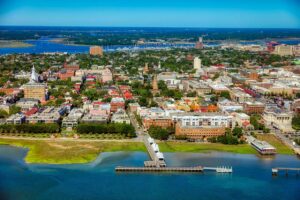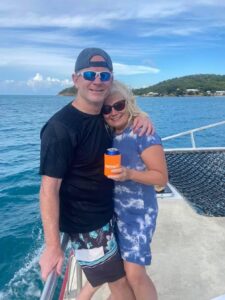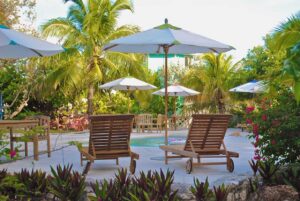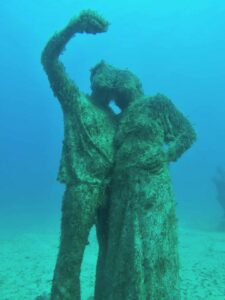Now that Americans can legally travel to Cuba by boat, we jumped at the opportunity to organize a voyage to the island for more than 100 of our fellow Ocean Reef Yacht Club members. Our flotilla of 17 boats began at the Stock Island Marina Village in Key West, where the staff and facilities are top notch. The new boutique Perry Hotel, located at the marina, hosted a fabulous bon voyage cocktail party for us the night before our early departure to Cuba. We departed Stock Island aboard our motor yacht Satori at 1 a.m., and arrived at Marina Hemingway in Cuba at 10 a.m. the following day.
After contacting the Cuban Coast Guard twelve miles out and the marina five miles out, we were greeted by the Hemingway International Yacht Club tender and escorted to the customs dock at Marina Hemingway. The uniformed Cuban customs and immigration officers boarded Satori to check our documents, inspect our contents and see what fresh food was aboard. A doctor and nurse in traditional uniform boarded to take our temperatures and ensure that we were not arriving ill. We were asked to disembark into a small office, where our passports were examined and photos taken.
We were already members of the Hemingway International Yacht Club, and had exchanged emails with its commodore about this trip. He was kind enough to greet us, and the yacht club tender led us to our slip. That evening, the yacht club welcomed our group with a traditional Cuban pig roast, and we partied the night away under the stars, dancing salsa and forming a conga line to the rhythms of a fabulous local band.
While Marina Hemingway is owned and managed by the Cuban government, the Hemingway International Yacht Club, located at the marina, is private. Under the stewardship of Commodore Escrich since 1992, the yacht club has enrolled more than 3,000 members from 73 countries. The commodore has spread his enthusiasm for the boating lifestyle and camaraderie among those at sea. Now celebrating its 25th anniversary, the yacht club has become a place for boaters to share their experiences at the bar over a mojito, in the lobby with a daiquiri or on the patio with a Cuba libre.
Our days were filled with learning about the colorful Cuban culture. Our comfortable tour bus took us along the picturesque Malecon, the famous fivemile-long seaside roadway that leads into Old Havana (La Habana Vieja). Brightly colored vintage cars were everywhere to admire, rent or hire with a local guide.
We walked the cobblestone streets and explored the four plazas, where we found Cubans posing in their native costumes, artists to draw our caricatures, musicians to entertain us and tiny tiendas selling handmade leather bags, fedoras and guayabera shirts. Bottles of Havana Club rum and Monte Cristo #2 cigars were also on our shopping lists. Other highlights included a stop at the famous Hotel Nacional, where we sipped mojitos and enjoyed the panoramic Havana harbor views, and a visit to Fusterlandia, a short distance from Marina Hemingway, where for more than 30 years the well-known artist Jose Fuster turned his studio and low-end surrounding neighborhood into a fantasy-like art piece with vibrantly colored mosaics and paint.
A ride outside the city took us to Finca Vigía, the former home of Ernest Hemingway and now a museum, where his boat Pilar is also on view. The property was a location in the 2016 movie “Papa Hemingway in Cuba,” a must-see prior to your visit. We concluded our Hemingway tour back in Havana at his two favorite bars, La Bodeguita del Medio for mojitos and El Floridita for daiquiris.
Mealtime is always a great way to experience a different culture, and Cuba is no exception. Restaurants are divided into those that are state run and those that are privately owned, known as paladars. It is good practice to always look at the menu prices, when available, or ask about them prior to ordering. More than once, we experienced differing prices for tourists. The exteriors of several of the paladars appeared old and run down, yet inside they were well appointed and a gourmet delight with exceptional service and mouthwatering presentations. Some of our favorites were the famous La Guarida, where the Oscarnominated “Strawberry and Chocolate” was filmed, La Cocina de Lilliam, San Cristobal Paladar, Doña Eutimia and Habana 61. Local dishes we especially loved included ropa vieja (shredded steak), tostones rellenos (stuffed plantains) and arroz congri (rice and black beans).
Our farewell dinner was held at the Club Habana, a magnificent setting overlooking the ocean. It featured a master cigar roller, a salsa class from a local dance academy and live music.
After our group rendezvous was over, we chose to stay in Cuba longer, and took a day trip to the town of Varadero in a 1950 Dodge Meadowland. Although the 90-mile ride was a slow one, we got to experience the countryside, which is filled with small villages, palm tree-lined routes and tiny roadside cafes. Our main goal was to see the new, state-of-the-art Marina Gaviota Varadero, perhaps for our next trip.
While crossing the Gulfstream on our way home, we reflected on the highlights of our trip. There were the midcentury buildings, the vintage cars, the delicious food, coffee and rum, but we all concluded that the standout was the Cuban people. Their kindness, dignity, devotion to family and laughter with friends compensate somewhat for the fact that they lack many of the privileges that we take for granted.
Adios, amigos!





